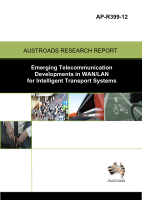Traffic Management

Emerging Telecommunication Developments in WAN/LAN for Intelligent transport systems
- Publication no: AP-R399-12
- ISBN: 978-1-921991-15-8
- Published: 1 March 2012
- PDF (free) Download
This report provides the background information on analog and digital communication and a review on the WAN and LAN technologies currently used by road agencies. It also describes the future WAN/LAN technologies including their use within the new National Broadband Network (NBN) infrastructure that will provide increased connectivity through more bandwidth and faster communication speed. These technologies were then compared on outsourcing models, risks and costs amongst other criteria. The issue of network availability, latency, resilience and security also receives attention.
- 1. introduction
- 2. BACKGROUND
- 2.1. Transmission of Data Using the Analog Telephone System
- 2.2. Digital Communications
- 2.3. Trends in Wide Area Networks
- 2.3.1. Analog Copper Networks Replaced by Digital Networks
- 2.3.2. RJ45 Ethernet Interface to Replace the RJ11POTS/PSTN Interface
- 2.3.3. Generic Ethernet Layer 2 and IP Layer 3 Availability
- 2.3.4. The Transition from IPv4 to IPv6
- 2.3.5. Telephone Connections via VoIP
- 2.4. Summary
- 3. Review of Wan and Lan technologies used by road agencies
- 3.1. Department of Transport and Main Roads, Queensland (TMR)
- 3.2. Roads Corporation, Victoria (VicRoads)
- 3.3. Roads and Maritime Services, New South Wales (RMS)
- 3.4. Main Roads Western Australia (MRWA)
- 3.5. ACT Department of Territory and Municipal Services (ACT TAMS)
- 3.6. NZ Transport Agency (NZTA)
- 3.7. Other Road Agencies
- 3.8. Summary
- 4. Future Wan/lan TECHNOLOGIES
- 4.1. Optical Fibre
- 4.2. Wireless Technologies
- 4.2.1. Wireless WAN (4G)
- 4.2.2. Wireless LAN (DSRC)
- 4.3. Licensed and Unlicensed Point-to-point and Mesh Wireless Solutions
- 4.4. The National Broadband Network
- 4.5. Summary
- 5. COMPARATIVE ANALYSIS OF WAN/LAN MANAGEMENT MODELS
- 5.1. Service Delivery Models
- 5.2. Selection Criteria
- 5.2.1. Changing Core Competencies
- 5.2.2. In-house Training and Accreditation Costs
- 5.2.3. Opportunity Costs for Internal Staff
- 5.2.4. Information Security
- 5.2.5. Information Transfer
- 5.2.6. Risk
- 5.2.7. Proprietary Technology and Lock-in
- 5.2.8. Service Level Agreements
- 5.2.9. Viability/Responsiveness
- 5.3. Cost Contributions
- 5.4. Examples of Current Models
- 5.5. Strategic Drivers for Increased Use of Industry in Service Delivery
- 5.6. Summary
- 6. Network availability, latency, Resilience AND SECURITY
- 6.1. Availability
- 6.2. Latency
- 6.3. Resilience
- 6.4. Security
- 6.5. Summary
- 7. Future work
- 8. Conclusions and recommendations
- References
- Appendix A LIST OF ABBREVIATIONS
- Appendix B QUESTIONNAIRE FOR STAKEHOLDER CONSULTATION
- Appendix C Latency Dependencies
- C.1 SCATS Latency Dependencies
- C.2 STREAMS Latency Requirements
- C.2.1 Level of Service
- C.2.2 Quality of Service
- C.2.3 Bandwidth
- C.3 Summary of SCATS and STREAMS Requirements
- C.3.1 SCATS
- C.3.2 STREAMS
- C.4 Summary
- Appendix D communication requirements in a traffic signal controller
- D.1 Communication with the ATCS
- D.2 Interface with Local Entities
- D.3 Security
- D.4 Use by External ITS Devices
Related publications
AP-R535-16
Latest Traffic Management News
